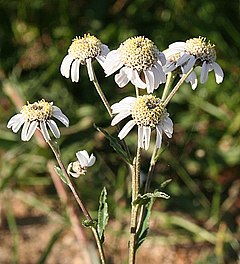Difference between revisions of "Sneezewort"
| Line 3: | Line 3: | ||
|genus=Achillea | |genus=Achillea | ||
|species=ptarmica | |species=ptarmica | ||
| − | |common_name=Sneezewort | + | |common_name=Sneezewort, Sneezeweed, Bastard Pellitory, European Pellitory, Etc. |
| − | |name_ref= | + | |name_ref=Wikipedia |
|habit=herbaceous | |habit=herbaceous | ||
|habit_ref=Flora - A Gardener's Encyclopedia | |habit_ref=Flora - A Gardener's Encyclopedia | ||
| Line 23: | Line 23: | ||
|usda_ref=Flora - A Gardener's Encyclopedia | |usda_ref=Flora - A Gardener's Encyclopedia | ||
|max_zone=10 | |max_zone=10 | ||
| − | |image= | + | |image=Sneezewort (Achillea ptarmica).jpg |
|image_width=240 | |image_width=240 | ||
}} | }} | ||
| − | + | '''''Achillea ptarmica''''' ('''Sneezewort''', '''Sneezeweed''', '''Bastard Pellitory''', '''European Pellitory''', '''Fair-maid-of-France''', '''Goose Tongue''', '''Sneezewort Yarrow''', '''Wild Pellitory''', '''White Tansy''') is a species in the genus ''[[Achillea]]''. It has loose clusters of white, button-like [[flower]]s that bloom from June to August. Its dark green [[Leaf|leaves]] have finely-toothed margins. | |
| − | + | ||
| − | + | This is a hardy, drought-tolerant plant that prefers full sun and moist but well-drained [[soil]]. | |
| − | + | ||
| − | + | The name ''ptarmica'' comes from the [[Greece|Greek]] word ''ptairo'' (=sneeze) and means 'causes sneezing'. | |
| − | + | ||
| − | + | Like many other plants, the sneezewort's pattern of development displays the [[Fibonacci number|Fibonacci sequence]].<ref name="Britton">{{cite web |url= http://britton.disted.camosun.bc.ca/fibslide/jbfibslide.htm |title= Fibonacci Numbers in Nature |author= Jill Britton |format= [[html]] |date= 7 May 2005 |quote= }}</ref> | |
| − | + | ||
| − | + | The plant is poisonous to cattle, sheep, and horses. | |
| − | + | ||
| − | |||
| − | |||
| − | |||
| − | |||
| − | |||
| − | |||
| − | |||
| − | |||
| − | |||
| − | |||
| − | |||
| − | |||
| − | |||
| − | |||
| − | |||
| − | |||
| − | |||
| − | |||
| − | '''''Achillea ptarmica''''' ('''Sneezewort''', '''Sneezeweed''', '''Bastard Pellitory''', '''European Pellitory''', '''Fair-maid-of-France''', '''Goose Tongue''', '''Sneezewort Yarrow''', '''Wild Pellitory''', '''White Tansy'''). | ||
{{Inc| | {{Inc| | ||
| − | Achillea ptarmica, Linn. (A. macrocephala, Pill. & Mitterb.). Sneezewort. Height 1-2 ft.: lvs. serrate: fls. in loose corymbs; all summer. North temperate regions.— Its full-double var. The Pearl | + | Achillea ptarmica, Linn. (A. macrocephala, Pill. & Mitterb.). Sneezewort. Height 1-2 ft.: lvs. serrate: fls. in loose corymbs; all summer. North temperate regions.— Its full-double var. The Pearl is much used for cut-flowers and in cemeteries, and is one of the most popular of all hardy herbaceous plants. There are many other varieties.{{SCH}} |
}} | }} | ||
| Line 90: | Line 71: | ||
{{stub}} | {{stub}} | ||
| − | + | __NOTOC__ | |
| − | |||
| − | |||
Latest revision as of 22:03, 2 November 2010
| Habit | herbaceous
| |
|---|---|---|
| Height: | ⇕ | 30 in"in" can not be assigned to a declared number type with value 30. |
| Width: | ⇔ | 30 in"in" can not be assigned to a declared number type with value 30. |
| Bloom: | ❀ | early summer, mid summer, late summer |
| Exposure: | ☼ | sun |
|---|---|---|
| Features: | ✓ | flowers, ground cover |
| USDA Zones: | 6 to 10 | |
| Flower features: | ❀ | white |
|
Achillea > |
ptarmica > |
Achillea ptarmica (Sneezewort, Sneezeweed, Bastard Pellitory, European Pellitory, Fair-maid-of-France, Goose Tongue, Sneezewort Yarrow, Wild Pellitory, White Tansy) is a species in the genus Achillea. It has loose clusters of white, button-like flowers that bloom from June to August. Its dark green leaves have finely-toothed margins.
This is a hardy, drought-tolerant plant that prefers full sun and moist but well-drained soil.
The name ptarmica comes from the Greek word ptairo (=sneeze) and means 'causes sneezing'.
Like many other plants, the sneezewort's pattern of development displays the Fibonacci sequence.[1]
The plant is poisonous to cattle, sheep, and horses.
Read about Sneezewort in the Standard Cyclopedia of Horticulture
|
|---|
|
Achillea ptarmica, Linn. (A. macrocephala, Pill. & Mitterb.). Sneezewort. Height 1-2 ft.: lvs. serrate: fls. in loose corymbs; all summer. North temperate regions.— Its full-double var. The Pearl is much used for cut-flowers and in cemeteries, and is one of the most popular of all hardy herbaceous plants. There are many other varieties.CH
|
Cultivation
- Do you have cultivation info on this plant? Edit this section!
Propagation
- Do you have propagation info on this plant? Edit this section!
Pests and diseases
- Do you have pest and disease info on this plant? Edit this section!
Species
Gallery
If you have a photo of this plant, please upload it! Plus, there may be other photos available for you to add.
References
- Standard Cyclopedia of Horticulture, by L. H. Bailey, MacMillan Co., 1963
External links
- w:Sneezewort. Some of the material on this page may be from Wikipedia, under the Creative Commons license.
- Sneezewort QR Code (Size 50, 100, 200, 500)
- ↑ Jill Britton (7 May 2005). "Fibonacci Numbers in Nature" (html).

